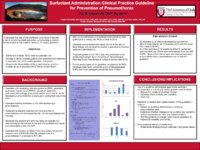The Graduate Nursing Project collection includes Doctor of Nursing Practice (DNP) Scholarly Projects and Master's students' non-thesis projects submitted as part of program requirements.
TO
Filters: Relation Is Part Of: "Graduate Nursing Project, Doctor of Nursing Practice, DNP" Collection: ehsl_gradnu Subject: "Resuscitation"
1 - 25 of 5
| Title | Creator | Date | Description | Relation Is Part Of | ||
|---|---|---|---|---|---|---|
| 1 |
 |
Flight Paramedics Can Safely Administer Blood Products to Trauma Patients: Decreasing the Time to Blood Administration Improves Patient Outcomes | Foley, Jenifer | 2019 | Background and Objectives Early administration of blood products to trauma patients in the prehospital setting is associated with improved outcomes. Paramedics are vital components of many flight teams but do not receive education on blood administration in their education track. The literature indi... | Graduate Nursing Project, Doctor of Nursing Practice, DNP |
| 2 |
 |
Effective Identification of Sepsis in the Emergency Department | Singer, Jessica | 2018 | Background: Severe sepsis is the leading cause of death at the University of Utah Hospital (UUH). In the University of Utah's emergency department (ED), sepsis capture and treatment remained at only 25%. We created an educational module and a sepsis checklist tool for the ED nursing staff which resu... | Graduate Nursing Project, Doctor of Nursing Practice, DNP |
| 3 |
 |
Surfactant Administration Clinical Practice Guideline for Prevention of Pneumothorax | Brinkerhoff, Tia | 2017 | POSTER | Graduate Nursing Project, Doctor of Nursing Practice, DNP |
| 4 |
 |
Surfactant Administration Practice Guidelines for Late Pre-Term and Greater Gestation Neonates | Brinkerhoff, Tia | 2017 | The purpose of this project was to develop a surfactant administration guideline to decrease the rate of pneumothoraces in moderate-late preterm and term neonates. Currently there are no clear guidelines for surfactant administration in this population yet research has pointed to significant benefit... | Graduate Nursing Project, Doctor of Nursing Practice, DNP |
| 5 |
 |
Determining Appropriate Use Between Minimally Invasive And Non-invasive Hemodynamic Monitoring In The Shock Trauma ICU | Kissell, Kristi | 2014 | Fluid resuscitation remains the mainstay of treatment for the hemodynamically unstable or hypotensive patient. Only approximately 50% of these patients are determined to have a therapeutic response to fluid administration also known as fluid responsiveness. Patients who receive over or under fluid r... | Graduate Nursing Project, Doctor of Nursing Practice, DNP |
1 - 25 of 5
